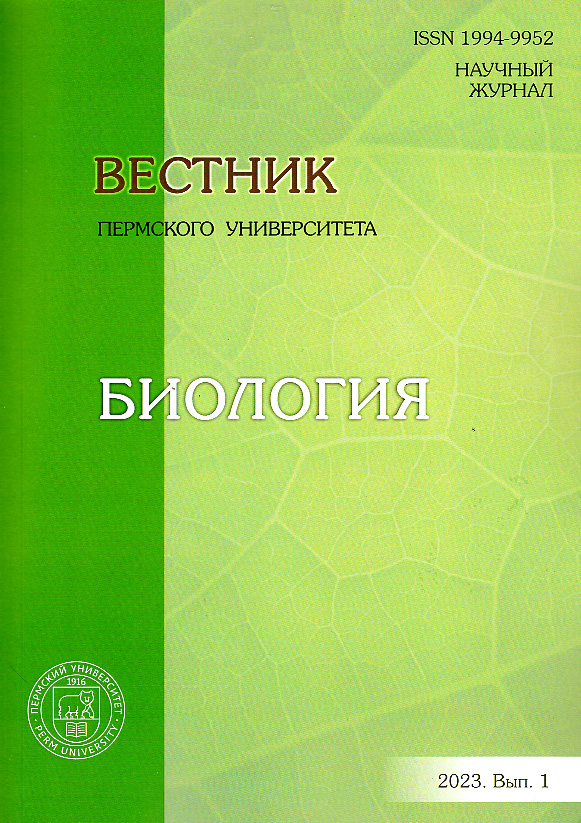The order Flavobacteriales: ecological features and clinical signifi-cance in the development of human pathology: review
Main Article Content
Abstract
Article Details
References
Боронина Л.Г. и др. Род Chryseobacterium (Flavobacterium): клиническое значение, идентификация, чувствительность к антибиотикам // Клиническая микробиология и антимикробная химиотерапия. 2003. Т. 5, № 3. С. 243–250. URL: https://cmac-journal.ru/publication/2003/3/cmac-2003-t05-n3-p243/
Зубова К.В. и др. Видовой состав представителей порядка Flavobacteriales, выделенных от пациентов с муковисцидозом в Российской Федерации за 2019−2021 гг. // Проблемы медицинской микологии. 2022. Т. 24, № 2. С. 74–75.
Abdalhamid B. et al. Chryseobacterium gleum pneumonia in an infant with nephritic syndrome // IDCas-es. 2016. Vol. 5. P. 34–36. DOI: 10.1016/j.idcr.2016.06.004
Garg S. et al. Pyonephrosis dueto Chryseobacterium gleum: a first case report // Indian Journal of Medical Microbiology. 2015. Vol. 2, № 33. P. 311–313. DOI: 10.4103/0255-0857.154894
Carvalho F.É.B., Marson A.L., Levy C.E. Challenges in the identification of Chryseobacterium indologenes and Elizabethkingia meningoseptica in cases of nosocomial infections and patients with cystic fibrosis // New Microbes and New Infections. 2017. Vol. 20. P. 27–33. DOI: 10.1016/j.nmni.2017.09.002
Guiu A. et al. Chryseobacterium spp., a new opportunistic pathogen associated with cystic fibrosis? // Enfermedades Infecciosas Microbiologìa Clìnica. 2014. Vol. 32, № 8. P. 497–501. DOI: 10.1016/j.eimc.2013.08.003
Hsueh P.R. et al. Flavobacterium indologenes bacteremia: clinical and microbiological characteristics // Clinical Infectious Diseases. 1996. Vol. 23, № 3. P. 550–555. DOI: 10.1093/clinids/23.3.550
Izaguirre-Anariba D.E., Sivapalan V. Chryseobacterium indologenes, an emerging bacteria: A case report and review of literature // Cureus. 2020. Vol. 12, № 1. Article e6720. DOI: 10.7759/cureus.6720
Janda J.M., Lopez-Denise L. Mini review: New pathogen profiles: Elizabethkingia anopheles // Diagnostic Microbiology and Infectious Disease. 2017. Vol. 88. P. 201–205. DOI: 10.1016/j.diagmicrobio.2017.03.007
Jean S.S. et al. Elizabethkingia meningoseptica: an important emerging pathogen causing healthcare-associated infections // Journal of Hospital Infection. 2014. Vol. 86, № 4. P. 244–249. DOI: 10.1016/j.jhin.2014.01.009
Kamran Z. et al. Empedobacter falsenii: a rare non-fermenter causing urinary tract infection in a child with bladder cancer // SOA: Clinical Medical Cases, Reports & Reviews. 2017. Vol. 1, № 1. P. 1–3. DOI: 10.12998/wjcc.v5.i5.187
Kenna D.T.D. et al. rpoB gene sequencing highlights the prevalence of an E. miricola cluster over other Elizabethkingia species among UK cystic fibrosis patients // Diagnostic Microbiology and Infectious Disease. 2018. Vol. 90. P. 109–114. DOI: 10.1016/j.diagmicrobio.2017.10.014
Kim K.K. et al. Transfer of Chryseobacterium meningosepticum and Chryseobacterium miricola to Eliz-abethkingia gen. nov. as Elizabethkingia meningoseptica comb. nov. and Elizabethkingia miricola comb. nov. // International Journal of Systematic and Evolution Microbiology. 2005. Vol. 55. P. 1287–1293. DOI: 10.1099/ijs.0.63541-0
Lin Y.-T. et al. Tigecycline and colistin susceptibility of Chryseobacterium meningosepticum isolated from blood in Taiwan // International Journal of Antimicrobial Agents. 2009. Vol. 34, № 1. P. 100–101. DOI: 10.1016/j.ijantimicag.2009.01.011
Marchandin H., Michon A.L., Jumas-Bilak E. Atypical Bacteria in the CF Airways // Diversity, Clinical Consequences, Emergence and Adaptation. 2012. URL: https://www.researchgate.net/publication/224829099. DOI: 10.5772/30253
McBride M.J. The family Flavobacteriaceae // The Prokaryotes. 2014. P. 643–667. DOI: 10.1007/978-3-642-38954-2_130
Mirza H.C. et al. Clinical strains of Chryseobacterium and Elizabethkingia spp. isolated from pediatric patients in a university hospital: Performance of MALDI-TOF MS-based identification, antimicrobial suscepti-bilities, and baseline patient characteristics // Microbial Drug Resistance. 2018. Vol. 24, № 6. P. 816–821. DOI: 10.1089/mdr.2017.0206
Pereira G.H. et al. Nosocomial infections caused by Elizabethkingia meningoseptica: An emergent path-ogen // The Brazilian Journal of Infectious Diseases. 2013. Vol. 17, № 5. P. 606–609. DOI: 10.1016/j.bjid.2013.02.011
Pickett M.J. Methods for identification of flavobacteria // Journal of Clinical Microbiology. 1989. Vol. 27. P. 2309–2315. DOI: 10.1128/jcm.27.10.2309-2315.1989.
Sharma D. et al. Empedobacter brevis meningitis in a neonate: A very rare case of neonatal meningitis and literature review // Case Reports in Pediatrics. 2016. Vol. 5. P. 1–4. DOI: 10.1155/2016/7609602
Snesrud E., McGann P., Walsh E. Clinical and genomic features of the first cases of Elizabethkingia anopheles infection in New York, including the first case in a healthy infant without previous nosocomial expo-sure // Journal of the Pediatric Infectious Diseases Society. 2019. Vol. 8, № 3. P. 269–271. DOI: 10.1093/jpids/piy071
Tural D.A. et al. Clinical characteristics of children with cystic fibrosis infected with unusual bacteria // Minerva Pediatr (Torino). 2021. Apr. 15. P. 111–114. DOI: 10.23736/S2724-5276.21.06189-2
Van der Velden et al. First report of a Wautersiella falsenii isolated from the urine of an infant with pye-lonephritis // Diagnostic Microbiology and Infectious Disease. 2012. Vol. 4, № 74. P. 404–405. DOI: 10.1016/j.diagmicrobio.2012.08.008
